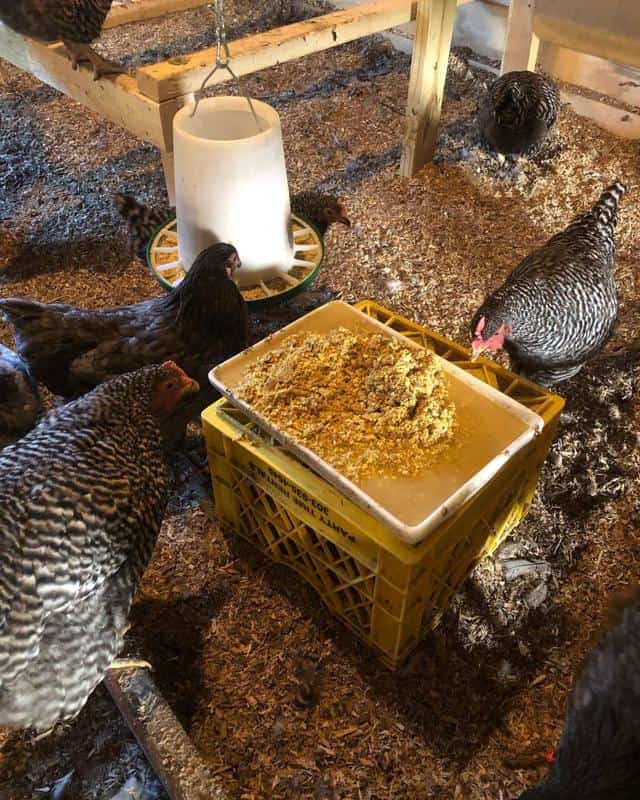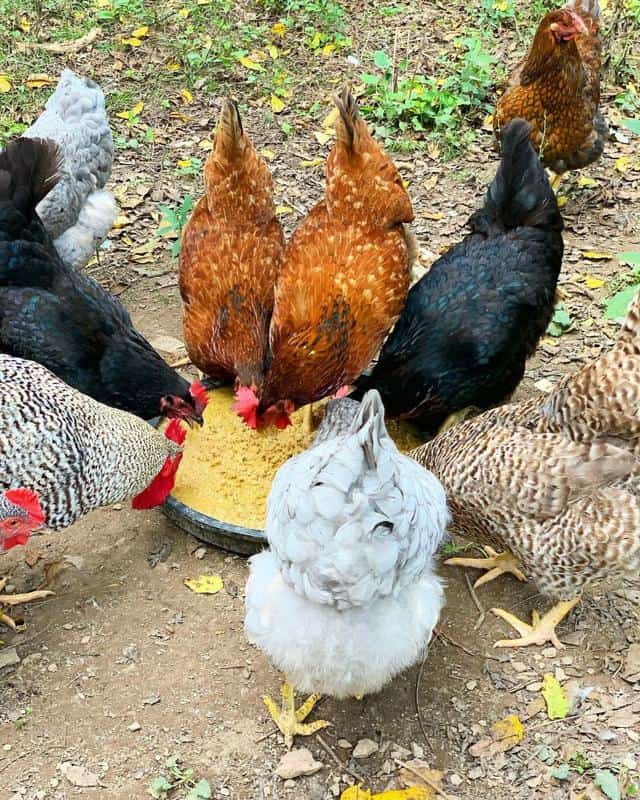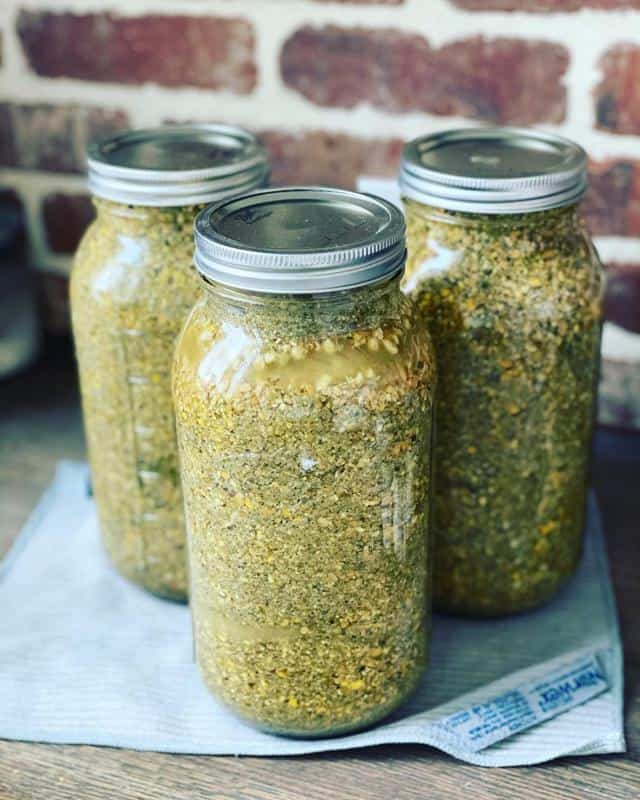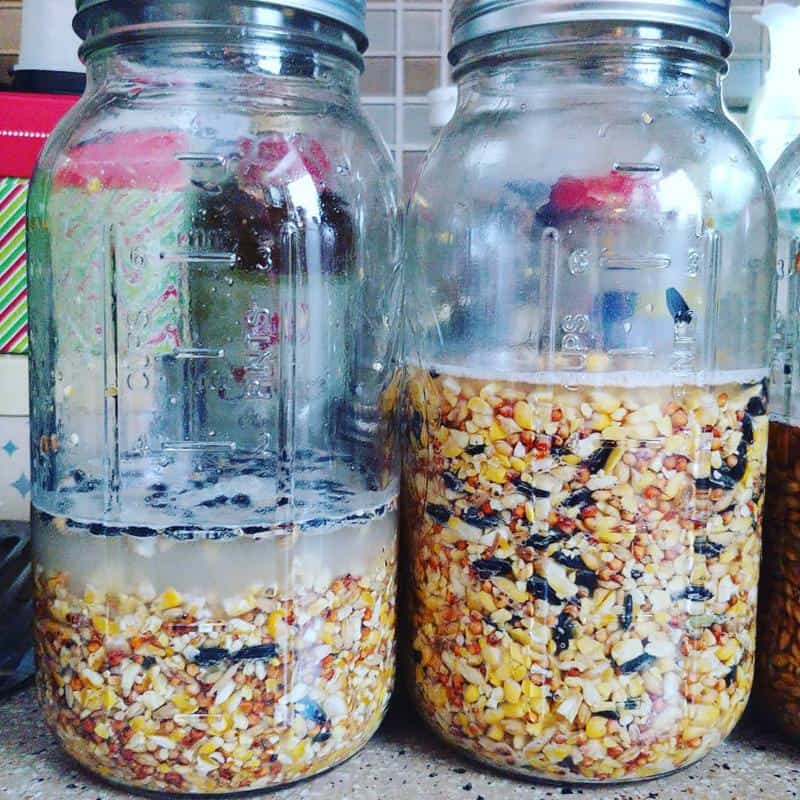If you have been looking for ways to keep your chickens happy, healthy and productive, all while reducing the amount you have to spend on them, you may have heard about the benefits of giving them fermented feed.
But what is fermented chicken feed? How do you make it? And what are the advantages of preparing it?
In this post, we have the answers to questions like these and more as we give you all the information you need about fermenting chicken feed.
What Is Fermented Food?

Fermentation – more specifically lactic acid fermentation – is the process whereby sugars are converted into lactate by bacteria.
Humans have been fermenting foods since the late Stone Age. Notable modern examples include kimchi, a central feature of Korean cuisine, and sauerkraut, which is considered a national dish in Germany.
Cheese and yoghurt are also among the most commonly eaten types of fermented food worldwide, and alcoholic drinks are also produced through the action of fermentation.
Originally, fermenting was used as a way of preserving food while also changing and improving the flavor. With foods such as cheese and yoghurt, fermenting is also the method used to produce food from milk.
However, more recently, foods like sourdough bread have become fashionable – and with modern science, we have also become increasingly aware of the beneficial properties of fermented food.
The health benefits are largely due to the production of probiotics and beneficial bacteria that are thought to complement our gut microbiota, thereby improving digestion and promoting overall health.
But it’s not just humans who can benefit from eating fermented foods – more and more chicken keepers have been waking up to the advantages of giving their birds fermented feed too.
So now let’s look at how fermented chicken feed can also benefit your flock.
What Are the Benefits of Fermenting Chicken Feed?

Although it might sound like some kind of internet fad, there are many distinct advantages to giving your birds fermented feed, and many of these advantages are backed up by hard science. Here are some of the most important benefits you can expect to see:
Improved Digestion and Nutrient Absorption
Fermented chicken feed is easier for chickens to digest, and this is partly because it’s softer than regular chicken feed.
However, more than this, it’s also easier for a chicken’s digestive system to absorb more of the nutrients from fermented food.
This is because the foods that make up a chicken’s staple diet such as grains, seeds and legumes contain something called phytic acid, a nutrient inhibitor that reduces the amount of nutrition the chicken can obtain from its feed.
When feed is fermented (and also when grains are allowed to sprout) the phytic acid content is reduced, making more of the nutrient content available to the chicken.
This means a chicken can obtain more protein from its feed, and vitamins such as vitamin B9 are also absorbed more easily.
Improved Gut Health
As well as making food easier to digest, the process of fermentation also produces beneficial bacteria that can help balance a chicken’s gut microbiota.
This in turn also helps improve digestion, but at the same time, it reduces the amount of undesirable, harmful bacteria.
One study showed that providing chickens with fermented feed helped lower the pH level in the gut, and this increased acidity seems to deter the growth of bacteria such as E. Coli and salmonella.
Improved Overall Health
The reduction of harmful bacteria such as E. Coli and salmonella along with improved gut health also leads to better overall health, but it also seems that giving fermented feed to chickens gives their immune systems a boost, further reducing disease.
For example, according to one study, giving fermented feed to broiler chickens reduced the mortality rate and improved immune responses to disease.
Better Quality Eggs
Another important and very welcome benefit of giving your chickens fermented food is an improvement in the quality and size of the eggs they produce – and again, this is backed by the science.
In a study on the effects of giving chickens fermented feed, it was demonstrated that chickens receiving fermented feed went on to produce eggs that were heavier overall, had heavier shells and also had stronger shells.
Reduction in The Quantity of Feed Required
Along with the benefits to your flock’s health and egg productivity, when giving chickens fermented feed, you can also expect to see a reduction in the amount of feed you need to provide for them.
Since feed is the main expense when keeping chickens, this may end up saving you a significant amount of money.
The reason chickens consume less when eating fermented feed is that the feed swells up when soaked, filling them up more quickly and leaving them feeling satisfied for longer.
However, at the same time, since the amount of nutrients that can be absorbed from the feed is increased, the chickens won’t miss out on any nutrients by consuming less food – if anything, they will receive more nutrients than before.
Generally speaking, chickens will consume about half the volume of feed if given fermented feed compared to regular feed, which means you can potentially reduce the amount you spend on feed by 50%.
Less Poop
Since your chickens will consume less feed and a higher proportion of the feed will be converted into energy, there will also be less waste coming out of the other end.
In addition, the consistency of the poop will be different – the poop of chickens that are given fermented feed tends to be drier and less smelly.
This will make it easier to clean up, your hen house will be less unpleasant to clean and the drier poop will also help further reduce disease in your flock.
Reduced Veterinary Bills
The combination of improved gut and overall health, improved immunity and improved sanitary conditions should also lead to a reduction in the amount you need to spend on veterinary bills, saving you even more money.
How Do You Ferment Chicken Feed?

With so many advantages to giving your birds fermented feed, you’re probably itching to find out how to prepare it.
The good news is that it’s very easy to do, and it won’t even take you that much time – so let’s have a look at how to do it now.
Materials needed
- Glass or ceramic jar or BPA-free plastic bucket
- Wooden spoon for stirring
- Cheesecloth or loose-fitting lid
- Rubber band for cheesecloth
- Chicken feed
- Dechlorinated water
Step 1 – Mix Feed in Water
Take a jar with about twice the volume of the amount of feed you plan to ferment and place the feed in the jar. Pour in the water so that it covers the feed.
The water level should be around two inches above the top of the feed because as the feed expands, this will ensure that it all remains submerged.
Also, make sure you use dechlorinated water since chlorine will prevent fermentation from taking place.
If you don’t have dechlorinated water available, you can simply use regular tap water – leaving it out for 24 hours before using it will cause the chlorine to evaporate off, making it suitable for use in fermentation.
Finally, take your spoon and stir the mixture – then cover the jar with a loose-fitting lid or with some cheesecloth and a rubber band.
The reason for this is to prevent mold spores from entering the mixture since they may cause mold to grow, spoiling your batch of feed. However, you shouldn’t seal the container tightly because gases produced by the fermentation process need to be allowed to escape.
Step 2 – Stir and Monitor
Over the next three to four days, you need to monitor the fermenting feed and stir it regularly.
If you prepare the mixture in the morning, you should come back to check it for the first time in the afternoon of the same day. You will probably notice that most of the water has been absorbed and the feed is near the top of the water.
If the feed has absorbed all the water and is no longer submerged, you should add about another inch of water.
Come back again to check on it in the evening. The level of the water should now be just above the top of the feed. If all is well, stir it and cover it over again for the night.
Following this, you should continue to check on the mix around three times a day, stirring it each time.
You will probably notice that the mixture begins to give off bubbles, in which case, everything is proceeding as it should.
It should also start to develop a sour but not unpleasant odor – but if it begins to smell bad or if mold starts to develop, it means it has become contaminated, so you’ll need to discard it and start again.
Under no circumstances should you feed moldy or foul-smelling feed to your birds.
Step 3 – Drain and Feed
After three or four days, the feed will be ready to give to your birds. It should have a tangy sweet yet sour yeasty smell and there should be bubbles on the surface.
If any water remains in the container, drain it off. After this, all you need to do is remove the feed from the fermenting container and feed it to your birds.
Note that once removed from the water, the feed will go bad quite quickly, so if you have made too much for your birds to consume in one meal, you can leave the rest in the water to preserve it.
However, if you do this, it will continue to ferment, and most chickens are unlikely to appreciate feed that has fermented for too long.
Fermented Chicken Feed Tips

Finally, here are a few extra tips to help you get the most out of making fermented feed for your chickens.
- Introduce slowly
Since chickens won’t be used to the taste of fermented food at first, it’s best to introduce it slowly. This way they will be able to become accustomed to the new type of food, and they are less likely to reject it.
- Experiment with different stages of fermentation with fussy chickens
The taste of the food and how strong it tastes will depend on how long you ferment it, so at the beginning, it’s worth experimenting with food that has been fermented for different amounts of time to see what your chickens prefer.
For example, fussier chickens might prefer food that has been fermented for three days – but any longer, and they might reject it.
- Date containers if making batches
If you are making regular batches of fermented feed to ensure your flock has a constant supply, using date labels on each container will help you keep track of how long the mix in each container has been fermenting.
- Use leftover fermentation water to start your next batch
If there is leftover water in the container when the mix is ready to give to your chickens, instead of tipping it away, you can add it to the next batch of feed you ferment.
Since it already contains the beneficial microorganisms that carry out the fermentation process, this fermentation “juice” can speed up the process of making the next batch by up to a day.
- Refrigerate leftovers to make them last longer
Once removed from the water, fermented feed can also be kept in a refrigerator for a couple of days to make it last longer.
- Don’t use a metallic jar for fermentation
Don’t use a metallic jar made of something like aluminum since the acid produced during fermentation will interact with the metal, spoiling the feed.
- Give your chickens fermented feed during times of stress
Even if you don’t normally have the time to make fermented chicken feed, it’s a good idea to give it to your chickens during times of stress – like during the annual molt or when they are suffering from illness.
This is because the extra nutrients can help boost their health, enabling them to recover more quickly.
Read More:
FAQs
What Kind of Feed Can Be Fermented?
Most kinds of feed are suitable for fermenting, including whole grains, seeds, starter feed, pellets, layer feeds and crumble.
However, the best types are unprocessed foods – like whole oats or sunflower seeds – since they naturally contain the yeasts necessary for the fermentation process to begin.
Fermenting chickens’ regular feed is recommended since this will ensure they receive all the necessary nutrients in their diet.
You can also ferment your own blends of chicken feed – but these should only be used as treats rather than as your birds’ main feed unless you are certain that your blend contains the full suite of nutrients that chickens require.
How Often Should You Give Fermented Food to Your Chickens?
Some chicken keepers go as far as replacing all regular chicken feed with fermented feed, and this is fine as long as the food you ferment is a balanced mix of feed that is designed to provide chickens with all their nutritional needs.
However, since preparing fermented feed can be time-consuming, giving your chickens fermented feed for around four meals a week can still ensure they receive all the benefits, and it will also still reduce the amount you spend on feed.
How Much Fermented Feed Do You Need per Chicken?
You should give your birds about the same amount of feed by volume as they would usually receive, but since fermented feed doubles in volume, you will end up feeding them about half as much as usual.
For example, if your chickens usually receive half a cup of feed per day, you should use a quarter of a cup of feed (before fermentation) since this amount will equate to half a cup of feed once fermentation has been completed.
How Long Does Fermented Chicken Feed Keep?
Once it’s ready, fermented chicken feed will keep for a day or two if left in the fermentation “juice” – although if it ferments for too long, your chickens might refuse to eat it.
However, once removed from the water, it will spoil quickly, so you will need to collect and discard any leftovers after each meal.
A Superfood for Chickens that Boosts Their Health and Improves Their Eggs
As we’ve seen, fermented chicken food can boost their health in several ways while also improving their egg quality and saving you some money at the same time.
Furthermore, making fermented chicken feed is simple and inexpensive, so it’s easy to give it a go to see how your birds benefit from eating it.
